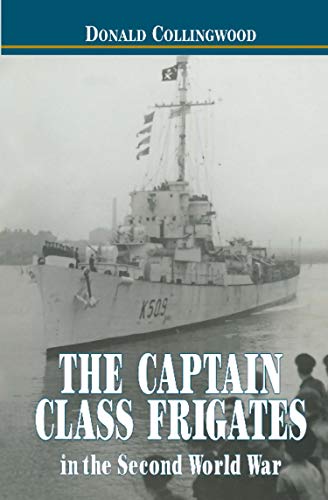Reviewed by CAPT Richard Dick, USN (Ret.)
Donald Collingwood’s Captain Class Frigates is both a history of a class of escorts important in the latter stages of World War II and also a fond memoir of both ships and men. Collingwood himself served in the Captain-class H.M.S. Cubitt from 1943 to 1946 in the Atlantic and the English Channel. He joined the Royal Navy in 1937 and retired in 1961, first publishing The Captain Class Frigates in the Second World War in 1999.
His book is a deeply researched, objective, and painstakingly complete history of all 78 American-built destroyer escorts which served in the Royal Navy under Lend-Lease as Captain-class frigates.
In 1941, a shortage of escort vessels suitable for the North Atlantic prompted the UK to order 50 (and later 100 more) of a proposed diesel electric destroyer escort (DE), the Evarts class, to be delivered starting in 1943. America’s entry into the war later in 1941 led to competition for the valuable ships, reducing the British share to 78, split between the Evarts and the turbo-electric Buckley class. While the US built over 500 DEs at several different shipyards with multiple propulsion plant configurations, the British units were all either turbo-electric or diesel electric and built in the Boston area, simplifying accommodations and training for the British crews brought to the US to accept the ships and sail them to the UK for further training and the installation of some specifically British systems (e.g., radars).
Rather than detailing the histories of each of the 78 Captain-class ships, Collingwood discusses the ships according to the escort groups or other commands in which they served. He also chronicles the use of Captains outside the ASW mission, such as serving as headquarters ships for the invasion of Normandy and as Coastal Forces Control Frigates with Allied light forces against German E Boats and other threats. He points out that, as a class, despite entering the war relatively late, Captains were the fourth most successful of 10 classes of British escort in terms of U Boats destroyed (36), a total exceeded only by the Loch-class frigates, Black Swan-class sloops, and V/W class destroyers.
The author does a solid job of describing the technical characteristics of the Captains as originally built, as converted for British service, and as modified during the war. However, his book is an operational and human history rather than a technical one and will not meet the needs of scale modelers. The small but valuable collection of photographs in this book focuses on people as much as on ships and Collingwood does not attempt to track the history of the modifications made to each individual ship of the class. His list of references directs the interested reader to several more detailed histories, such as Peter Elliott’s surveys of World War II Allied escorts.
Collingwood writes well and pulls few punches. He acknowledges the ships’ strengths (messing, accommodation, air defense armament) and weaknesses (weak main armament, shock sensitive electrical breakers, poor gyrocompasses). He also notes the early Captains could be quite unpleasant in heavy seas, a fact that Norman Friedman discusses at more length in his British Destroyers and Frigates: the Second World War and After.
The greatest strength of the book is the human stories, such as the experiences of the crews in the United States and the hard fought ASW battles of 1944 and 1945 as the U Boats moved into shallower waters and employed the snorkel in an ultimately unsuccessful attempt to regain operational freedom. Some are amusing, such as when a Captain-class ship (probably Bayntun) accidentally fired a 3” practice shell into a Boston cemetery in workups. Others are more somber, such as the 50 per cent loss rate of the Captains in the First Escort Group. Overall, Collingwood’s book is an excellent history of a successful class crewed by brave and skillful men in a demanding and frequently deadly environment.
Captain Dick is a retired submariner who also served for over 29 years in the defense intelligence community.
The Captain Class Frigates in the Second World War (Donald Collingwood, Naval Institute Press, Annapolis, MD, 2020; Originally Donald Collingwood, Pen & Sword, Barnsley, South Yorkshire, Great Britain, 1999).



Bob Young